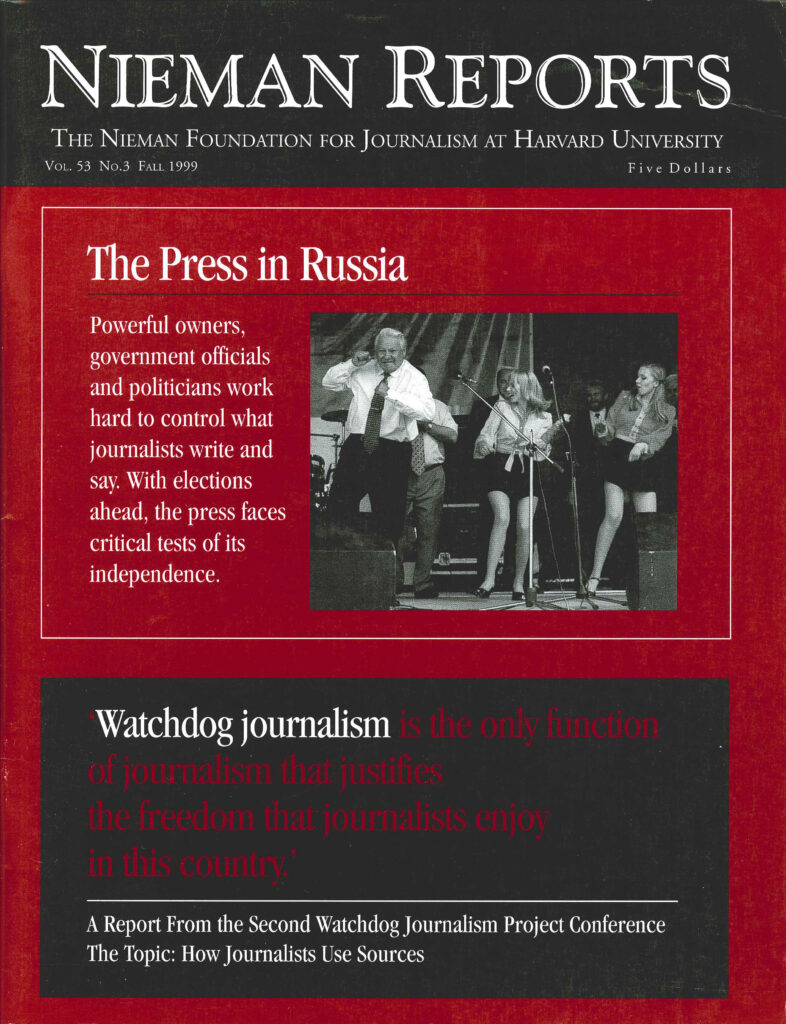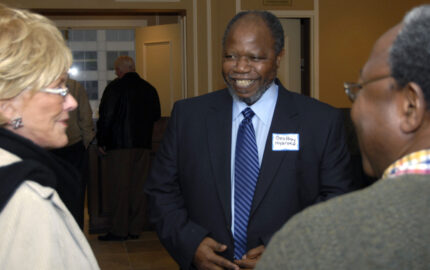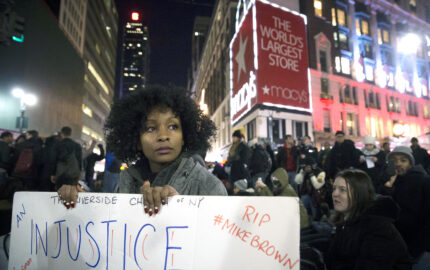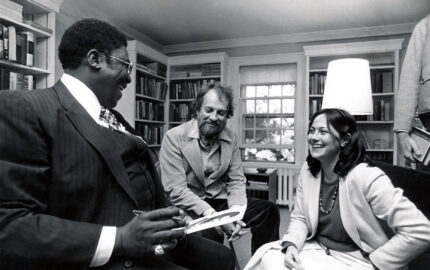To many, the only real news that came out of the Unity ’99 conference was GOP presidential candidate George W. Bush’s attempt to bypass the largest gathering of minority journalists ever even though he was campaigning at the same time in Seattle. I know. I wrote the story that convinced him at the last minute to alter his schedule for a brief, impromptu walkabout at the convention.
But Unity ’99 wasn’t about presidential politics.
No, for most of the estimated 6,000 people attending Unity ’99 last July, the gathering was the largest and most multiracial group of journalists to assemble in one place. Over the course of five days, there were workshops, speeches and cocktail parties involving media industry chatter. Those attending were primarily, but not exclusively, representing the Asian American Journalists Association, the National Association of Black Journalists, the National Association of Hispanic Journalists and the Native American Journalists Association.
The oft-stated goal of Unity ’99 promoters was to unite a divided collective of “journalists of color” into a single force. Implicit is their ultimate ambition of pressing the establishment media for greater racial, ethnic and gender diversity at all levels in the nation’s newsrooms.
I feel that’s too much to ask; it is a burden on racial minorities that’s unfair and impossible to achieve. Why should black, Latino, Native American and Asian journalists be the exemplars of unity, allowing the larger journalistic community—or society at large—off the hook?
Five years ago, at the first Unity convention in Atlanta, the organizations struggled among themselves to pull off the first combined convention of minority journalists. This year’s meeting was even more difficult to make happen than the first. During the run-up to the 1999 convention, the constituent organizations wrestled with whether to hold the meeting in Washington state, where voters had repealed affirmative action programs.
If NABJ, the largest of the minority groups, had convinced its members to stay away, the turnout might have been reduced and organizers might have been forced to cancel the long-planned meeting. Millions of dollars would have been lost to the organizations. In the end, black journalists retreated from a potentially crippling boycott threat, and the convention was spared.
“It’s a very, very powerful thing,” Catalina Camia, President of Unity: Journalist of Color, Inc., the umbrella organization that organized the convention, said to me as delegates arrived. “Our voices raised together are immanently louder and more powerful than a single voice.”
Well, voices certainly were raised in protest of the overwhelming whiteness of America’s news industry, as well they should be. According to a survey commissioned by the Freedom Forum’s Media Studies Center in New York, 55 percent of journalists of color at U.S. dailies expect to leave the business. Another study by the Latino journalist group drew attention to the “network brownout” on national news broadcasts, pointing out that less than a single percent of their reports were about Hispanics.
And so it went, from an early-bird’s Town Hall meeting on Tuesday night (before more delegates arrived on Wednesday) that allowed Seattle residents to vent their frustrations over the lack of coverage in minority communities to a closing ceremony on Saturday night aimed at “Celebrating Our Future,” the themes of race and ethnicity were front and center. One particularly insightful workshop session dealt with “How TV News Portrayals of Race and Class Impact Children.”
But I’m not sure very many people got the intended message. It’s an old story, better told in the 1969 Kerner Commission Report, which lambasted the media for covering the world “from the standpoint of a white man’s world.” Not much has changed on that front in 30 years, except far too many Americans tune out when the subject arises.
For me, deeply mired in the daily muck of news, Unity ’99 offered a brief glimpse of what could be in the nation’s newsrooms. If given the opportunity, journalists of color will talk about the broad and complex issues that confront all journalists. We might even write a story that prompts a presidential candidate to adjust his schedule. To be sure, if journalism improves, the nation’s minority populations—including journalists—will gain. But America will benefit even more.
This forest-not-trees view of the convention can even make believers of the people who can change newsrooms. The New York Times’s Washington Bureau Chief Michael Oreskes was one of the many white men—mostly job recruiters and newsroom executives—making the rounds, as one put it to me years ago, “to wave the company’s flag.” Just as minority journalists find themselves surrounded by an ocean of white faces in their newsrooms, white recruiters at minority meetings are outnumbered and appear less than at ease.
Yet, Oreskes told me a week after returning from Unity ’99, the experience was refreshing. “It was more than a convention of minorities,” he said. “It was more like the national journalism convention that we don’t otherwise have.”
Oreskes spoke at one New York Times-sponsored workshop on writing and beat reporting. He was struck by the eagerness of the college age and entry-level journalists in his audience. They pulled out notebooks and scribbled furiously. They asked probing questions. They wanted to know how to hone their skills, how to develop sources, how to write clear leads and how to tell stories. Simply put, they wanted to know journalism.
Later, Oreskes said he talked with a diverse group of people at the convention. Executives and human resource people, photographers and Web page designers, young eager beavers and grizzled veterans. Race talk was minimal. Mostly the conversations were about the craft of journalism, hiring choices, management decisions, ethics and so forth. “I was amazed at the range of people who were there,” he said. “We don’t have, in a formal way, across the spectrum, any other place where so many people come together to talk about our craft. There are other journalism conferences such as ASNE (the American Society of Newspaper Editors) and IRE (Investigative Reporters and Editors), but those groups are more limited and restricted to a narrower group of people.”
He’s so right. And, that makes the point for racial diversity more eloquently than all the preaching to the converted that otherwise transpires at minority gatherings. When more newsroom executives engage in conversations about their shared craft with minorities among them, they’ll hear what Oreskes heard: Diversity can be fractious and noisy and troublesome, but it makes the best brand of journalism.
Sam Fulwood III, a 1994 Nieman Fellow, covers race and politics as a Washington correspondent for the Los Angeles Times.
But Unity ’99 wasn’t about presidential politics.
No, for most of the estimated 6,000 people attending Unity ’99 last July, the gathering was the largest and most multiracial group of journalists to assemble in one place. Over the course of five days, there were workshops, speeches and cocktail parties involving media industry chatter. Those attending were primarily, but not exclusively, representing the Asian American Journalists Association, the National Association of Black Journalists, the National Association of Hispanic Journalists and the Native American Journalists Association.
The oft-stated goal of Unity ’99 promoters was to unite a divided collective of “journalists of color” into a single force. Implicit is their ultimate ambition of pressing the establishment media for greater racial, ethnic and gender diversity at all levels in the nation’s newsrooms.
I feel that’s too much to ask; it is a burden on racial minorities that’s unfair and impossible to achieve. Why should black, Latino, Native American and Asian journalists be the exemplars of unity, allowing the larger journalistic community—or society at large—off the hook?
Five years ago, at the first Unity convention in Atlanta, the organizations struggled among themselves to pull off the first combined convention of minority journalists. This year’s meeting was even more difficult to make happen than the first. During the run-up to the 1999 convention, the constituent organizations wrestled with whether to hold the meeting in Washington state, where voters had repealed affirmative action programs.
If NABJ, the largest of the minority groups, had convinced its members to stay away, the turnout might have been reduced and organizers might have been forced to cancel the long-planned meeting. Millions of dollars would have been lost to the organizations. In the end, black journalists retreated from a potentially crippling boycott threat, and the convention was spared.
“It’s a very, very powerful thing,” Catalina Camia, President of Unity: Journalist of Color, Inc., the umbrella organization that organized the convention, said to me as delegates arrived. “Our voices raised together are immanently louder and more powerful than a single voice.”
Well, voices certainly were raised in protest of the overwhelming whiteness of America’s news industry, as well they should be. According to a survey commissioned by the Freedom Forum’s Media Studies Center in New York, 55 percent of journalists of color at U.S. dailies expect to leave the business. Another study by the Latino journalist group drew attention to the “network brownout” on national news broadcasts, pointing out that less than a single percent of their reports were about Hispanics.
And so it went, from an early-bird’s Town Hall meeting on Tuesday night (before more delegates arrived on Wednesday) that allowed Seattle residents to vent their frustrations over the lack of coverage in minority communities to a closing ceremony on Saturday night aimed at “Celebrating Our Future,” the themes of race and ethnicity were front and center. One particularly insightful workshop session dealt with “How TV News Portrayals of Race and Class Impact Children.”
But I’m not sure very many people got the intended message. It’s an old story, better told in the 1969 Kerner Commission Report, which lambasted the media for covering the world “from the standpoint of a white man’s world.” Not much has changed on that front in 30 years, except far too many Americans tune out when the subject arises.
For me, deeply mired in the daily muck of news, Unity ’99 offered a brief glimpse of what could be in the nation’s newsrooms. If given the opportunity, journalists of color will talk about the broad and complex issues that confront all journalists. We might even write a story that prompts a presidential candidate to adjust his schedule. To be sure, if journalism improves, the nation’s minority populations—including journalists—will gain. But America will benefit even more.
This forest-not-trees view of the convention can even make believers of the people who can change newsrooms. The New York Times’s Washington Bureau Chief Michael Oreskes was one of the many white men—mostly job recruiters and newsroom executives—making the rounds, as one put it to me years ago, “to wave the company’s flag.” Just as minority journalists find themselves surrounded by an ocean of white faces in their newsrooms, white recruiters at minority meetings are outnumbered and appear less than at ease.
Yet, Oreskes told me a week after returning from Unity ’99, the experience was refreshing. “It was more than a convention of minorities,” he said. “It was more like the national journalism convention that we don’t otherwise have.”
Oreskes spoke at one New York Times-sponsored workshop on writing and beat reporting. He was struck by the eagerness of the college age and entry-level journalists in his audience. They pulled out notebooks and scribbled furiously. They asked probing questions. They wanted to know how to hone their skills, how to develop sources, how to write clear leads and how to tell stories. Simply put, they wanted to know journalism.
Later, Oreskes said he talked with a diverse group of people at the convention. Executives and human resource people, photographers and Web page designers, young eager beavers and grizzled veterans. Race talk was minimal. Mostly the conversations were about the craft of journalism, hiring choices, management decisions, ethics and so forth. “I was amazed at the range of people who were there,” he said. “We don’t have, in a formal way, across the spectrum, any other place where so many people come together to talk about our craft. There are other journalism conferences such as ASNE (the American Society of Newspaper Editors) and IRE (Investigative Reporters and Editors), but those groups are more limited and restricted to a narrower group of people.”
He’s so right. And, that makes the point for racial diversity more eloquently than all the preaching to the converted that otherwise transpires at minority gatherings. When more newsroom executives engage in conversations about their shared craft with minorities among them, they’ll hear what Oreskes heard: Diversity can be fractious and noisy and troublesome, but it makes the best brand of journalism.
Sam Fulwood III, a 1994 Nieman Fellow, covers race and politics as a Washington correspondent for the Los Angeles Times.



